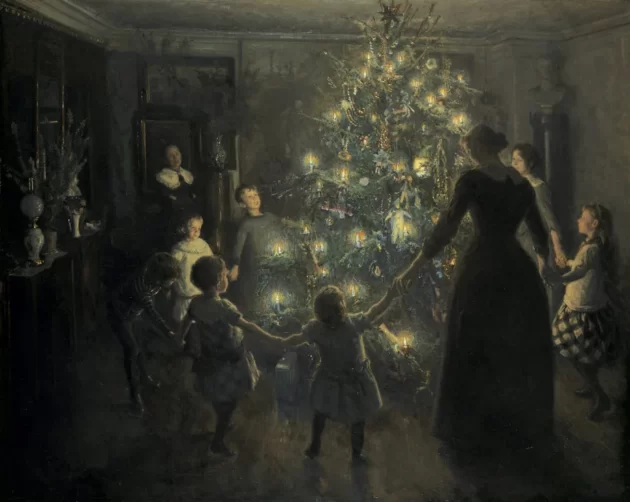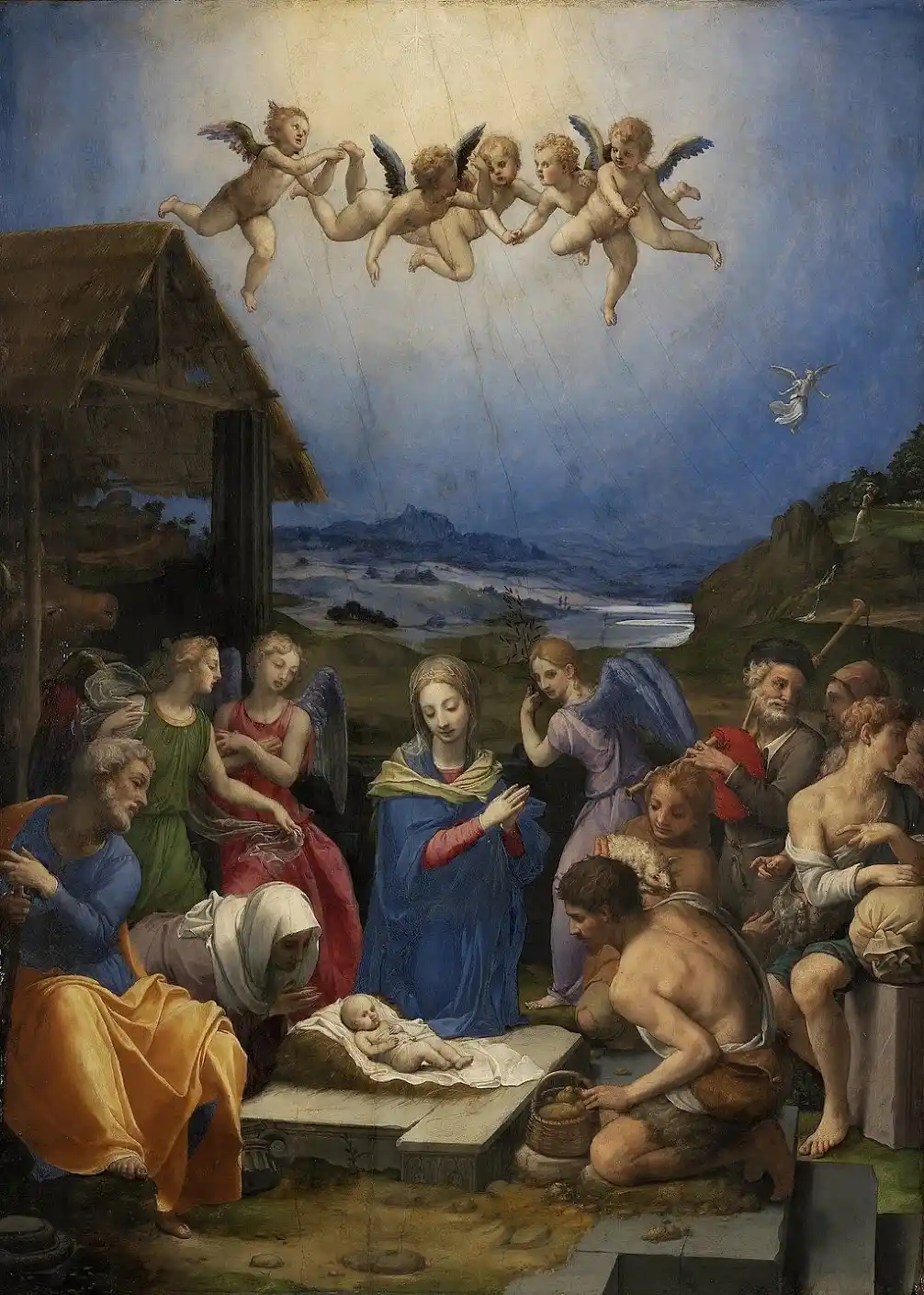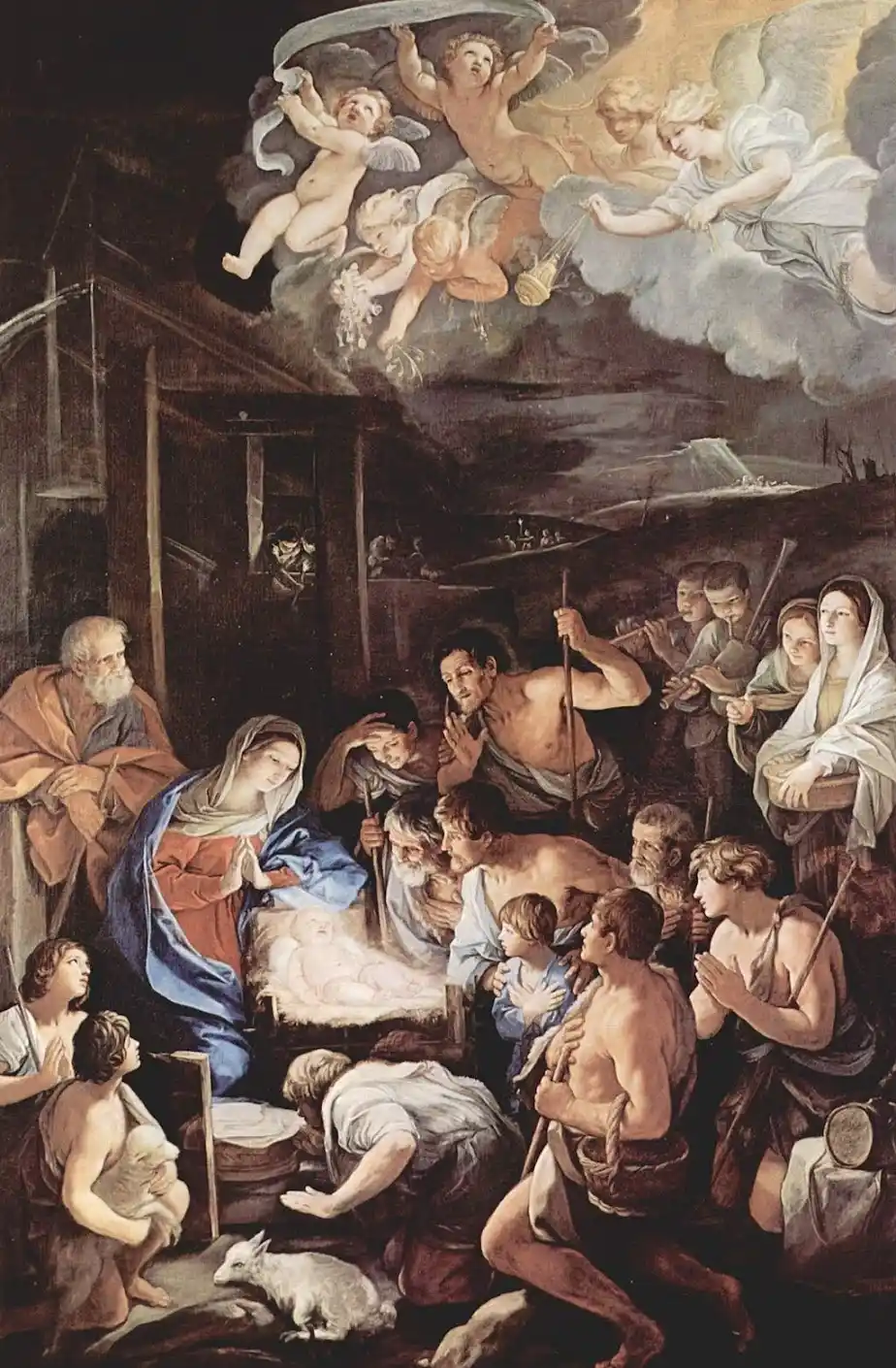Christmas in Art: The Most Beautiful Christmas Themed Artworks blog post was first published on Culture Tourist on 22 December 2023, and updated on 20 December 2024.
Christmas in art is represented by numerous paintings from the Middle Ages until modern times. In earlier art, especially in the Renaissance and Baroque, it was depicted by the Nativity scenes and representations of adorations of the shepherds. However, since the mid-19th century, when modern traditions like Christmas tree decorating and carolling developed, they also started to get represented in Christmas paintings. In this article, you can enjoy some of the most beautiful paintings depicting Christmas in art.
Christmas in Art
Giotto di Bondone: Nativity (1303 – 1305)
Where is it: Scrovegni Chapel in Padua, Italy
The first artwork in this selection of Christmas art representations is a fresco painting from the Scrovegni Chapel in Padua. The extensive work in the chapel required Giotto to hire forty artists to work with him. In this fresco, Giotto created one of the first representations of the Nativity scene in Western art that will set an example for many to come later.
⤷ Read more: Winter in Art – 20 Most Beautiful Winter-Themed Paintings
Domenico Ghirlandaio: Nativity and Adoration of Shepherds (1485)
Where is it: Sassetti Chapel, Santa Trinita Basilica in Florence, Italy
Domenico Ghirlandaio is one of the most famous Italian Early Renaissance painters who made this artwork for the Sassetti Chapel in the Santa Trinita Basilica in Florence. His goal was to show the nativity and adoration of the shepherd’s scenes realistically by focusing on details. He painted shepherds on the right-hand side, including his own portrait as a man with brown hair. The painter’s attention to detail is evident in the texture of fabrics and Roman references in architecture. When comparing it with Giotto’s Nativity, Ghirlandaio presents the same subject much more naturally.
⤷ Read more: 10 Cultural Spots to Visit in Florence
Rogier van der Weyden: Nativity – Bladelin Altarpiece (c. 1450)
Where is it: Gemäldegalerie, Berlin, Germany
Rogier van der Weyden’s Nativity scene is a central part of a triptych known as the Bladelin Altarpiece. He painted it later in his career, and it’s the only Nativity scene definitely attributed to that painter. He painted Mary and Joseph kneeling in front of the Baby Jesus. Outside the stable is a donor of the painting, dressed in black. Although the scene is set in Bethlehem, the architecture in the background shows a contemporary Flemish town.
Pieter Bruegel the Elder: The Census at Betlehem (1566)
Where is it: Royal Museums of Fine Arts of Belgium, Brussels, Belgium
In his famous painting, Pieter Bruegel the Elder showed a scene happening shortly after Christ was born. We can see the Virgin Mary with Baby Jesus on a donkey and Joseph walking beside them. However, he is setting it up in a contemporary environment. With the gabled houses and clothing, we recognise a 16th-century Flemish village. However, the ruins of a castle on the right resemble the architecture of Amsterdam. This painting is unique in art history because it’s one of the first paintings with a large part dedicated to the winter landscape.
⤷ Read more: The Best Museums in Brussels
Giorgione: The Adoration of the Shepherds (1505 – 1510)
Where is it: National Gallery of Art, Washington, D.C., USA
Although some researchers attribute this painting to young Titian, this Adoration of the Shepherds is mainly considered to be painted by Giorgione. The painter placed Holy Family and shepherds on the right-hand side of the painting, in front of a dark cave. The left part is reserved for the landscape with some architecture and trees. With its intimate atmosphere, the artwork has a very personal feel. However, an interesting detail in this painting is the representation of angels. Although they are usually present in these scenes, here, we can only see their illuminated heads, almost as if they were lamps above the cave entrance.
Antonio da Correggio: Adoration of the Shepherds (1529 – 1530)
Where is it: Gemäldegalerie Alte Meister, Dresden, Germany
This Nativity scene, painted by the Italian painter Antonio da Correggio, is also known as The Holly Night and Adoration of the Shepherds. Correggio was a master of light and an artist primarily interested in experimenting with it. You can see that well in this artwork. The source of light is Baby Jesus, which gives the painting an overall divine feel. Correggio also created a fantastic chiaroscuro effect that way.
⤷ Read more: The Travelling Artists & Artworks in Renaissance Europe
Fra Angelico & Fra Filippo Lippi: Adoration of the Magi (c. 1440/1460)
Where is it: National Gallery of Art, Washington, D.C., USA
This Adoration of the Magi is a circular painting, or a tondo, painted with tempera on wood. The painting was created over an extended time with more painters working on it. In the lower part of the painting, we see Saint Joseph and the Virgin Mary with Baby Jesus. In front of him are three Magi presenting their presents, with a large procession behind them. A fascinating part of this artwork is its different animals: ox, donkey, horses, camels, peacock, goshawk, and pheasant.
⤷ Read more: 25 Beautiful UNESCO World Heritage Sites in Europe
Bronzino: Adoration of the Shepherds (1539-1540)
Where is it: Museum of Fine Arts, Budapest, Hungary
Although it may seem like a massive painting, Bronzino’s Adoration of the Shepherds is a relatively small oil on wood with dimensions of 65 x 47 centimetres. The artwork shows a typical Bronzino’s Mannerist style with long masculine figures and distinctive colours. Bronzino loved to paint with one of the most expensive blue pigments, lapis lazuli, which you can notice in many parts of this painting.
Gerard van Honthorst: Adoration of the Shepherds (1622)
Where is it: Wallraf-Richartz-Museum, Cologne, Germany
Gerard van Honthorst is a Dutch Golden Age painter who, like many other 17th-century painters from the Netherlands, was strongly influenced by Caravaggio. His usage of light makes that influence visible in this painting, too. As in Correggio’s painting, Baby Jesus is the light source, illuminating the faces of people around him. The intimate atmosphere this painting has makes it one of the most beautiful examples of Christmas in art.
⤷ Read more: 10 Things to Do During the Christmas Season in Amsterdam
Peter Paul Rubens: The Adoration of the Magi (1609 & 1628 – 1629)
Where is it: Prado Museum, Madrid
The elaborate Adoration of the Magi painting by Peter Paul Rubens shows a much more complex Baroque composition than the previous example of this theme. It was painted in 1609 and repainted again between 1628 and 1629. Rubens made a few versions of paintings with this same subject.
An exciting story is linked to the painting. In 1734, a fire broke out in the Madrid Royal Alcatraz, where the artwork was held. It had to be cut out of the frame and thrown away through the window to be saved from the fire. The painting was saved, and only minor cuts and damages on its edges still witness this event.
Guido Reni: The Adoration of the Shepherds (c. 1640)
Where is it: Certosa di San Martino, Naples, Italy
Guido Reni’s Adoration of the Shepherds is a typical painting of that subject and a common representation of Christmas in art. He painted baby Jesus in its centre with his mother and Saint Joseph behind her. Shepherds and their families gathered around a child, illuminating them. As a balance, he painted a group of angels in the sky celebrating the birth of Baby Jesus.
⤷ Read more: 15 Best Museums to Visit in Europe
Charles Le Brun: Adoration of the Shepherds (1689)
Where is it: Louvre Museum, Paris
Commissioned by the French King Louis XIV, this artwork was part of a series of paintings representing the life of Christ. It captures perfectly the essence of Christmas in art. The Nativity scene is so recognisable that you can imagine it being transferred under your Christmas tree. Filled with different figures, Le Brun mostly used blue and orange colours to execute this painting.
Unknown author: Christmas Tree Decoration (second half of the 19th century)
Where is it: Private collection
Modern Christmas customs like tree decorating or carolling developed in the second half of the 19th century. That changed the representation of Christmas in art, as well. Before that time, we mostly find religious themes of Christmas in artworks. However, with the development of modern art and society, we can also see more Christmas celebrations in art. The painting here is an excellent example of it. A young man decorates his Christmas tree with glass and paper ornaments, as many of us do each year.
⤷ Read more: Christmas Traditions in Europe
Marcel Rieder: Decorating the Christmas Tree (1898)
Where is it: Private collection
Marcel Reider was famous for creating intimate scenes by using lamps in interiors or sunsets for exteriors. You can see that well in this painting, too. The emphasis is on the illuminated Christmas tree with a woman in a shadow decorating it. The artwork was probably presented at the Paris Salon in 1898. Rieder also created a lovely Christmas atmosphere with a lot of green and red colour in the painting.
Viggo Johansen: Merry Christmas (1891)
Where is it: Hirschsprung Collection, Copenhagen, Denmark
Viggo Johansen was a Danish artist known for his interior paintings with soft light effects and family life scenes. This gathering of a family singing around a Christmas tree represents it perfectly. An interesting motif in this painting is the Christmas tree itself. It shows a typical and fashionable way of decorating it with lit candles at the end of the 19th century. That custom is a predecessor of Christmas lights that are globally popular today.
Paul Gauguin: Christmas Night, The Blessing of the Oxen (1902-1903)
Where is it: Indianapolis Museum of Art, Indianapolis, USA
With the depiction of his motives and choice of colours, Paul Gauguin shows both French and Javanese influences in this artwork. We see the Virgin with the Child in a small hut on the right-hand side of the painting. However, the majority of the image is reserved for the winter landscape and ladies bringing in the oxen. Gauguin uses lots of blue and green in his artwork, painting the snow that way. He also uses the contrasting colours of blue and orange in his own style.
Edvard Munch: Christmas in the Brothel (1903 – 1904)
Where is it: Munch Museum, Oslo, Norway
In his Christmas in the Brothel, Edvard Munch paints a different side of holidays. He shows people from the edge of society celebrating the holiday together. Edvard Munch made this painting during a difficult period in his life and after visiting a brothel in Lübeck. Women working in a brothel have just finished decorating the Christmas tree. The painting brings a certain melancholy, while the colours he used show the influence of Fauvism.
⤷ Read more: The Most Intriguing Art Heists in European Museums
Christmas in art is represented with so many different themes and styles. I hope you enjoyed this selection of artworks with a Christmas theme. Which one is your favourite? Let me know in the comments!



















